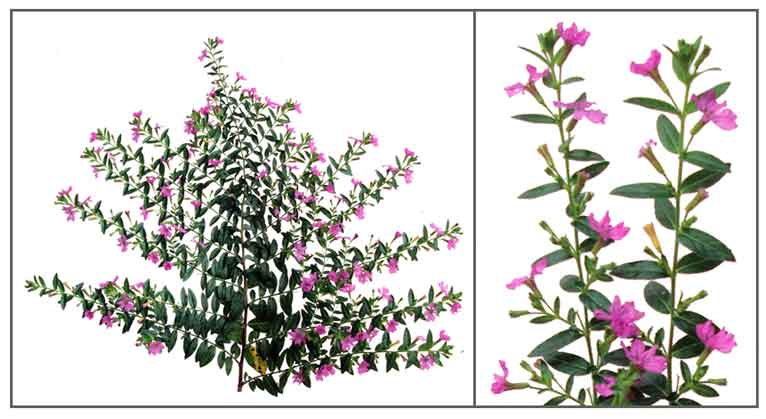|  Etymology Etymology
- Cuphea is a genus containing about 260 species of annual and perennial flowering plants native to warm temperate to tropical regions of the Americas.
-
The genus epithet "Cuphea" comes from the Greek word kypnos, meaning "curved", ,erring to the shape of the seed capsules; while the species name "hyssopifolia" means "hyssop-leaved", referring to the fine, narrow shape of the leaves, like the herb Hyssop. (11)- It is not a true heather, its common name "false heather" comes from its leaves resemblance to those of Scotch heather (Calluna vulgaris). (11)
- The plant has gained the Royal Horticultural Society's Award of Garden Merit
.
 Botany Botany
Cuphea hyssopifolia is a small evergreen much-branched
subshrub growing to 1.5 meters. Stems are semi-woody, slender and crooked.
Leaves are green, opposite, stalkless and numerous on the branches,
narrow-lanceolate, up to 1.5 centimeters long. Flowers are small, purplish violet
to light purple with green calyx.
Distribution
- Recently introduced
to the Philippines.
- Popular as a hedge plant.
- Native to Mexico and Guatemala.
- Propagated by stem cuttings.
Constituents
• Study isolated
two new ellagitannin dimers, cuphiins D1 and D2, with six known compounds
including oenothein B and woodfordin C from the aerial part of Cuphea
hyssopifolia.
• Contains flavone pigments.
•
Study isolated four macrocyclic hydrolyzable tannin dimers: cuphiin D1, cuphiin D2, oenothein B and woodfordin C. (see study below) (5)
• Aerial parts yielded diterpenes and flavonoids: friedelan-3β-ol (1), ursolic acid (2), methyl gallate (3), quercetin (4), quercetin-3-O-α-rhamnopyranoside (5), 1,2,3,4,6-penta-O-galloyl-β-D- glucose (6) and manitol (7). (7)
• Methanol extract of aerial parts yielded valoneic acid dilactone (1), 1,3−O−digalloyl-4,6- hexahydroxydiphenoyl- β-D−4C1-glucopyarnose (2), gallic acid (3), genistein-7-O-β-D-4C1 glucopyranoside (4), myricetin−3 − O− β-D−4C1-glucopyarnoside (5), 3, 4, 5-trimethoxy benzoic acid (6), vanilice acid (7) and quercetin (8). (see study below) (8)
• Study of aerial parts yielded two new ellagitannin dimers, cuphiins D1 and D2, six known compounds viz., 1,2,3,6-tetra-O-galloyl-β-D-glucose, 1,2,3,4,6-penta-O-galloyl-β-D-glucose, tellimagrandin II, oenothein B and woodfordin C and myricitrin. (11)
.
Properties
• Studies have suggested hypolipidemic, antitumor, antioxidant, cytotoxic, immunomodulatory, hepatoprotective properties.
 Parts used Parts used
Leaves, stems, aerial parts.
Uses
Folkloric
- No recorded folkloric
medicinal use in the Philippines.
- In Brazil, used to treat
high cholesterol and triglycerides.
- In French Guiana, stem
and leaf macerated in rum and rubbed onto sprains. Leaf infusion used
for colds and chills.
- In Bangladesh, used as tonic and insect repellent; also used for dermatitis, fever, and cough. (9)
Others
- Insecticide: Used as insecticide.
Studies
• Cholesterol
Lowering : Biochemical analysis of animals treated with
aqueous extract showed a significant reduction of plasma cholesterol
in rats; no effect was noted on glucose and triglyceride levels. (1)
•
Cuphilin / Anti-Tumor Activity:
(1) Study isolated cuphilin D1 (CD1), a new macrocyclic hydrolyzable tannin,
has been shown to exert in vivo and in vitro antitumor activity. Further
study showed CD1 induced cytotoxicity to HL-60 cells (human promyelocytic
leukemia cells. The CD1-induced apoptosis was attributed to inhibition
of Bcl-2 expression in HL-60. (2) Cuphiin D1 (CD1) significantly inhibited the growth of human cervical carcinoma, i.e. HeLa cells, with less cytotoxicity to normal primary-cultured cervical fibroblasts. CD1 also inhibited Bcl-2 expression in HeLa cells and may account for the Cd1-induced apoptosis. (2)
• Anti-Tumor / Anti-Cancer: Study isolated four macrocylic tannin dimers: cuphiin D1, cuphiin D2, cenothein B and woodfordin C. All significantly inhibited the growth of the human carcinoma cell lines KB, HeLa, DU-145, Hep 3B and the leukemia cell line HL-60. Results suggest the anti-tumor effects of the compounds are not only related to their cytotoxicity on carcinoma cell lines but also on some host-mediated mechanism. (5)
• Cuphiin D1 / Cytotoxic Effect on Human Cervical Carcinoma Cell Line: Cuphiin D1 (CD1), a macrocyclic hydrolyzable tannin isolated from Cuphea hyssopifolia has been shown to exert in vitro and in vivo antitumor effect. CD1 also significantly inhibited the growth of human cervical carcinoma, i.1., HeLa cells. This study investigated the cytotoxic mechanism of CD1 on HeLa cells. CD1 showed dose-dependent cytotoxic effect with IC50 of 14.2 µg/ml for 48 hours. HeLa treated cells exhibited chromatin condensation, indicating the occurrence of apoptosis. Inhibition of Bcl-2 expression in HeLa cells may be responsible for the CD1-induced apoptosis. (6)
• Antioxidant / Cytotoxic / Aerial Parts: Study evaluated the antioxidant and cytotoxic activities of a methanolic extract of aerial parts of C. hyssopifolia. The antioxidant activity in DPPH testing was comparable to that of ascorbic acid at 98.35%. It showed moderate cytotoxic activity along tested cell lines viz MCF7 (breast carcinoma cell line), HEP2 (larynx carcinoma cell line), HCT116 (colon carcinoma cell line) and HEPG2 (liver carcinoma cell line. (see constituents above) (8)
• Immunomodulatory Effects /
Cuphiin D1: Cuphiin D1 has been shown to exert antitumor activity both in vitro and in vivo. Study investigated CD1 for effects on proliferation and cytokine secretion of human peripheral blood mononuclear cells. Results showed CD1 could stimulate PBMCs release of IL-1 beta, IL-2, and TNF-alpha and activate T cells. CD1-activated T cells via IL-1 beta in vitro may account for the host mediated mechanism of action. (10)
• Hepatoprotective / Paracetamol Toxicity / Leaves: Study evaluated the hepatoprotective effect of methanol leaf extract of Cuphea hyssopifolia on paracetamol-induced hepatotoxicity in experimental rats. Silymarin was used as standard reference drug. CH significantly reduced (p<0.05) the raised liver enzymes level and increased serum levels of superoxide dismutase (SOD) and catalase, while reducing lipid peroxidation level via a decrease in serum maondialdehyde. (12)
Availability
- Wildcrafted.
- Seeds, plants in the cybermarket.
|

![]()

